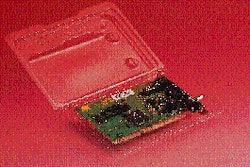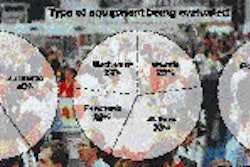To paraphrase Ronald Reagan, "Here they go again." Yep, it's the Europeans, back with their latest effort to erect standards or barricades at their borders. At least that is the view of some U.S. packaging executives. Last time it was the ISO 9000 quality assurance standards, introduced in 1989 and revised in 1994. This time it is the ISO 14000 series of environmental standards. The first and arguably the most important, 14001, is set to become final this fall. "We got caught with our pants down on 9000," says Alfred McKinlay, an independent packaging consultant who formerly chaired the D-10 packaging committee within the American Society for Testing and Materials (ASTM). ISO (International Organization for Standardization) 14001 is an environmental specification that does not directly address packaging or any other product attribute. Rather, it describes, among many other things, how a company must inventory the environmental aspects of its products and services. Complementary environmental auditing standards 14010, 14011 and 14012 will become final at approximately the same time. Beyond those four, there are a number of other standards in the works including, for example, 14024, which deals with environmental labeling. Strong European flavor? Even before 14001 goes into force, however, U.S. companies are worrying that it and the rest of the series will be too influenced by the Europeans. "Certainly they have the potential to be used as non-tariff trade barriers," says Mike Schmidt, director of research services at Amway Corp. (Ada, MI). He was formerly director of packaging at the company. "Among the environmental assessments of 14001, companies will be required to comply with one on product packaging." Schmidt notes that the 14000 series standards represent a considerable opportunity for European mischief in the area of packaging. He refers to a draft European Community waste directive called DG11 that was tabled in May. Had it become a standard, the stage would be set for its inclusion, or attempted inclusion into one of the 14000 standards. DG11 would have prohibited the use of the U.S. Society of the Plastics Industry resin code on the bottom of plastic packages and required companies to print, either on a label or the package itself, the percentage of recycled content used in the package. That DG11 threat could easily resurface again within the context of ISO 14024, the labeling standard. A Draft International Standard on "environmentally preferrable" [sic] labeling is expected to be published in late 1996. This would establish guidelines for programs such as Germany's Blue Angel, Japan's EcoMark and the U.S.'s Green Seal (which is privately run). Of course, the imposition of "environmentally preferrable" labels are anathema to most U.S. companies. The Grocery Manufacturers of America has pushed the U.S. Trade representative to lead an assault on these European "eco-label" programs within the World Trade Organization. Jim Connaughton, an attorney in Washington whose firm represents companies such as General Electric, Kodak, Apple Computer and Amway, heads the U.S. delegation to the ISO committee working on 14024. The committee is called TC207. "This has been one of the more controversial, difficult 14000 standards," he admits. When that 14024 standard came up for an initial vote in the summer of 1995, the U.S. and some other countries voted "no." A revised standard is kicking around. It was discussed at an ISO meeting in Rio de Janeiro in June. "There appears to be progress," states Connaughton. The concern about undue European influence over the 14000 standards arises because of a perception that they are being developed in parallel with the European standards-setting body called Comite Europeen de Normalisation (CEN). CEN has the responsibility of implementing the Eco-audit and Management Scheme legislation passed by the European Union in April 1995. CEN has agreed to accept the ISO 14000 standards, if they are finalized quickly enough. To accommodate CEN, ISO agreed to a 30-month timetable. The TC207 committee has 50 voting members, all of whom are officials of the standards bodies in those particular countries. The U.S. is represented by the American National Standards Institute (ANSI). Most of the hard work on a standard is done in committee. Not surprisingly, four of the six imminent standards currently being voted on by all 140 countries who are members of ISO are also being voted on in parallel by CEN members for acceptance as European regional standards. Some believe the U.S. has played a much stronger, more effective role in molding the 14000 standards than it did in crafting ISO 9000 standards. "These standards will not be troublesome," reports Joseph Cascio, vice president of the Global Environment & Technology Foundation (Annandale, VA). Cascio is chair of the U.S. Technical Advisory Group (TAG) to TC207. "14000 is American oriented." Nonetheless, Cascio adds, "There should be no illusion that ISO 14001 will be easy to implement. Even organizations with sophisticated environmental programs will find ISO 14001 challenging." Conventional wisdom says the ISO 14000 standards pose the biggest potential problem for mid-size U.S. companies who export to Europe from U.S. manufacturing facilities. The expense of becoming registered for these firms will be more difficult to absorb than for a Fortune 500 company. Moreover, that Fortune 500 company probably sells into Europe from European-based manufacturing facilities. The corollary is that smaller companies that do no exporting can ignore the standards completely. Tim Jensen, technical services manager for the masking and packaging systems division at 3M Co. (St. Paul, MN), generally agrees with those notions. But he adds, "Even a non-exporting company may find it earns a competitive advantage by obtaining 14001 registration." Most companies will have to dig fairly deep into their pockets for that registration, says Mary Saunders, chief of global standards policy at the National Institute of Standards and Technology. She estimates the cost for 14001 registration will be about the same as the cost for 9000 registration: $1ꯠ-$1귔 per day for auditors plus their travel expenses. That cost can be anywhere from $5ꯠ-$7ꯠ for a smaller company. But Saunders explains that auditing expenses represent only 20% of the total cost. The balance, a full 80%, is made up of internal costs derived in preparing for registration. Of course the 14000 standards would suddenly become important to even tiny companies if the Environmental Protection Agency (EPA) decides to accord them some form of recognition. Kathy Morgan, director of technical committee operations at the ASTM, a key liaison to Cascio's TAG and a participant at the Rio 14000 meetings in June, says, "Industry is cautious. Part of the hesitancy is that the EPA has not taken a stance yet." Mary McKiel, a top EPA standards official, says the agency will not "in any way, shape or form" encode the 14000 standards into any kind of regulatory requirement. Rather, the agency is deciding what, if any, enforcement leeway it ought to accord a company that wins a 14000 registration. There is an EPA task force looking at this issue. McKiel and others had a meeting on July 12 with EPA Deputy Administrator Fred Hansen on the 14000 issue. "We understand 14001 is very important; and it is important for us to understand the opportunities it presents," she states. Some resources for more details about ISO 14000 follow:
























